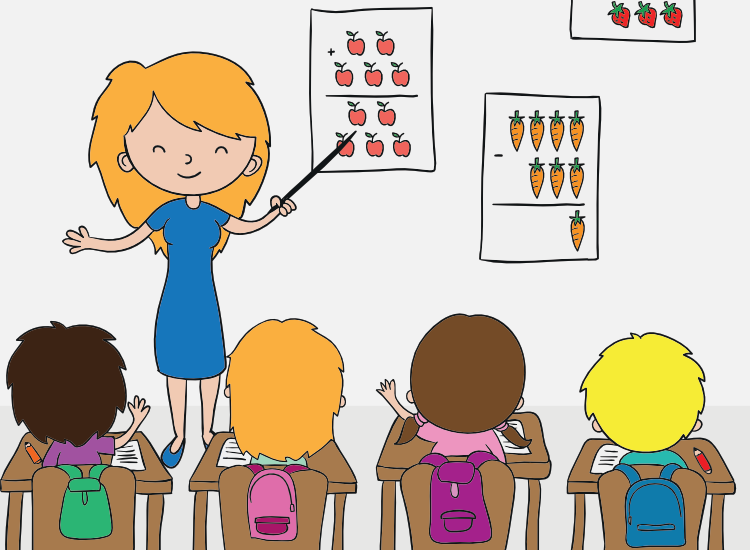
There is so much vocabulary to be used in an English-speaking classroom along with phrases as well!
Teachers have many different ways of telling students to do things and also of interacting with their students in a social way. In addition, students have their own phrases to communicate with each other and also to talk to their teacher.
This article will discuss a few examples of phrases used in the classroom. These phrases are mostly familiar to me from British classrooms but I have tried to add American variations as well.
We will go through the school day in chronological order, so it is an easy step-by-step guide:
Here we go!
Beginning the day
It’s the morning and things are crazy at school, friends are sitting down chatting and teachers are organising for the day ahead. We start first with the register:
1. Register (role-call)
The teacher takes (or ‘does’) a register every day to make sure they know who is present in the class and who is absent. The teacher would initiate this process by saying something like:
- Now, class, we are going to take (or ‘do’) the register.
At this point students would have to be silent and respond only when their name is called with “present” or “here”.
It is considered impolite to answer with “Yep” or “Mhm” and some schools even make students answer “Yes Sir/Miss”.
Also, the teacher may use the register to ask students about previous absences or times when they were not in class. Parents are usually required to inform the school about why their child was not present, but they may also write a note in the student’s “journal” or “contact book”.
It can also be a time for the teacher to talk to students and ask them what they did at the weekend or if they saw the big game on television last night.
Mrs Smith: Johnny?
Johnny: Here, Miss!
Mrs Smith: Did you watch the Arsenal match last night? It was fantastic!
Johnny: Yes! It was brilliant Miss, I didn’t know you watched football!
Often, there will be a “register monitor” which is a student nominated to deliver the register from the classroom to the school office. This is a big responsibility but most students love to do it!
Often after the register, there might be a bit of noise as students are excited, so then the teacher may gently use this phrase…
2. Is everybody ready to start?
This is something the teacher would say at the start of the lesson, mainly to gain attention.
Often after the register is taken, students begin talking and chatting about what they did yesterday or something they think is more interesting than school! So, the teacher saying “Is everybody ready to start?” is not really asking polite question but rather “Can everyone pay attention, please? I’m starting the lesson”.
Other examples of this include:
- I’m waiting…
- Settle down please.
- We won’t start until everyone is quiet.
- Okay, that’s enough…
And if that doesn’t work, the teacher will say politely:
3. Fingers on lips!
Another one that’s used to keep people quiet!
Teachers may say this if there is an argument or a group of children that are making too much noise in the class. It’s a way to cut through this noise and make sure everyone knows the teacher is in charge. The idea then is that the children literally put their fingers on their lips to stop them speaking over each other.
Then maybe the teacher will encourage the class to share ideas together about what they did at the weekend or something interesting that they have to show the class. They can do this in a couple of ways or by using a couple of activities.
4. Homework excuses
In the morning, students usually have to hand in their homework so that it can be graded by the teacher. This is definitely one for the students, excuses for not having done homework!
Here are 5 of the best:
- The dog ate my homework. – I don’t know if this has ever actually happened, but its the classic excuse for all students.
- I did it but I left it at home. – This is a brilliant excuse because the student can pretend to be surprised and also claim to be a good student having done the assignment!
- I left it in my mum’s car. – Same as above, although the danger here is that the teacher may call your mum to ask her to bring the homework that isn’t complete!
- I didn’t know it was due today. – An excuse that sometimes works, but usually not in my experience. The student claims that they thought it was due on a different day (usually after the weekend) to gain some more time.
- I have a note from my parents. – Fantastic, as long as you actually have the note to backup the excuse! This is usually a lie.
If you are a teacher, you need to be ready to see these excuses on a regular basis! And if you’re a student, well maybe it’s time to start doing the homework (or to start thinking of some better excuses).
Activities
It’s time for the first activities of the day! Everyone is ready to start learning and having fun.
1. Show and Tell (showtime)
Show and Tell is a part of the class where students bring in something that is special or important to them and talk about it to the rest of the class. This helps students that may be shy or timid to participate and contribute to class discussion whilst gaining confidence.
This is an exercise generally used with younger students, but I have also used it with older, more mature students to get them talking and asking each other questions.
It can also be highly entertaining!
Here is an example of a show and tell dialogue:
Mrs Smith: Now, Ben has brought in something to show the class! Ben, what have you brought for us?
Ben: I have brought my dad’s guitar. I love listening to him play it. It has six strings and it is brown.
Mrs Smith: That’s great! Can you play the guitar?
Ben: A little bit, my dad teaches me a new song every month so that I can play little bits of music!
Mrs Smith: Fantastic, thank you for sharing Ben!
This can be done in many different ways. You can ask students to show and tell as a whole class, or you can ask three people each day to prepare something, that way it won’t take up the whole lesson.
2. Circle Time
This is very similar to Show and Tell and also helps to get students talking!
It is a very good way to facilitate a group discussion and would be fantastic with all language learners of all ages. In Circle Time, the class sits in a circle and will take it in turns to speak about a chosen subject.
The thing is, they can only speak whilst they are holding an object and when a student does not have the object, they cannot speak. This helps to keep people focused and listening to each other.
3. Find a partner/get into groups of (number)
These phrases are used for group work and to get students to work together.
Some classes have predetermined groups to make sure that friends aren’t always together.
Mrs Smith: Now, class, get into groups of three please! We’re going to do an activity.
Ben: Miss, can I work with James and Ricky?
Mrs Smith: Of course you can, as long as your group is a group of three, it’s not a problem!
Ben: Yay, thanks miss!
Be careful, this one can cause chaos as students are moving all over the place and often teachers will start counting down from 10 to add a sense of urgency!
4. Come up to the front and show the class!
Teachers can ask students to come up to the front of the class for a variety of reasons but we will focus on the good ones.
It can be an honour for a student to go to the front! It means that your work is great or you have done something really well, much better than the other children!
Here are a few examples:
- Come up to the front and explain the problem to the class – this is a reward for somebody who is doing well in class. They can explain it to the students to make everyone understand it better.
- Come up to the front and write your answer on the board – This can be fantastic for students because usually the board is reserved for the teacher’s writing!
Sometimes if the student does well, the teacher will tell the class to give them a round of applause which means that they get clapped for their efforts! This is a great feeling!
Lunchtime
Lunchtime! Finally!
Before anything, the teacher will check that everyone has their lunch because if not, then he/she will need to get them some lunch.
1. Does everyone have their lunch?
Followed by…
- Who has a packed lunch? – A packed lunch is a lunch that a student has brought. This will usually be sandwiches and fruit with a few small treats.
- Who is having a hot dinner? – A hot dinner is provided by the school usually for a small fee.
Lunchtime is a great time of the day for students because (if the weather is good) they get to go outside and eat their lunch whilst also playing sport or another type of game.
There are lots of possible games to play at lunchtime:
- Sport – football, rugby, basketball – Depending on the equipment you have!
- Tag – Everyone runs around the playground, one person is “It” which means they have to try and catch other people by chasing them and then touching them. The person that is touched becomes “It” and they chase everyone else.
- Catch – You throw a ball to each other and try to catch it.
- Dodgeball – More American, but a game where you have to try and dodge (move out of the way) a ball that is thrown at you!
Ben: Jamie, do you want to play dodgeball when I’ve finished my sandwiches?
Jamie: No, everyone is playing tag! Then after we are going to play football.
Ben: Okay! Let me finish my lunch and I’ll be there!
End of the day (home time)
After a few more activities and lessons comes home time!
A child’s favourite time of the day, time to go home! Here are some things that the teacher may say:
1. Pack your things away
This phrase can be used to make students tidy up the classroom.
Often after an art class or another class requiring a lot of equipment, students will have made a mess. The teacher certainly does not want to tidy the class by themselves so they ask the students to do it for them!
This usually happens 5 minutes before the end of class and should be done very quickly. To make this happen, the teacher will often offer a reward for the quickest people to tidy up and sit down such as a sweet or a sticker.
Other examples of this include:
- Tidy up time!
- Tidy your things away!
- I need the classroom spotless in 5 minutes!
There may be some time left before the bell rings so the teacher will carry on talking…
2. Have you had a good day?
A nice way to end the day is to ask students if they have had fun at school or even What did you learn today?
This can be an excellent way to end things and to make sure that students are learning. It also gives the students another opportunity to talk and express themselves!
Look at the dialogue below:
Mrs Smith: Okay children, it’s the end of the day! But before we go, Ellie, have you had a good day?
Ellie: Um… Well I loved painting, I think I would like to be an artist one day!
Mrs Smith: Great! You are a really good artist! Now, Ben, what did you learn today?
Ben: Well, I learned that quadrilaterals are shapes with 4 sides.
Mrs Smith: Very good! That’s exactly right!
This makes sure that the students go home happy and ready to tell their parents all about what they have done today.
These are all great phrases to use in a classroom environment!
What do you think?
Teachers, what phrases do you like best?
Students, which phrases would you be scared to hear?
If you have any additions please add them in the comments below!
More for you:
64 Classroom & School Objects

























hi I’m zein new student to English help me
Great